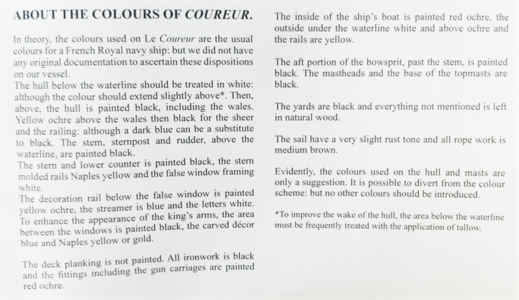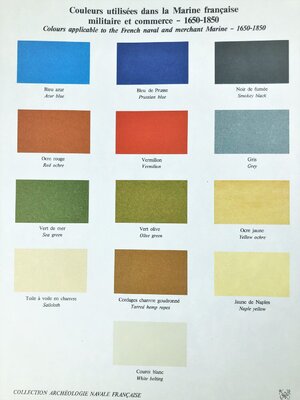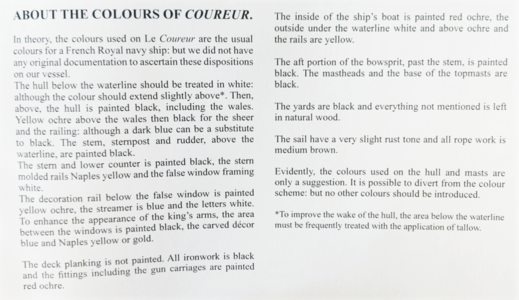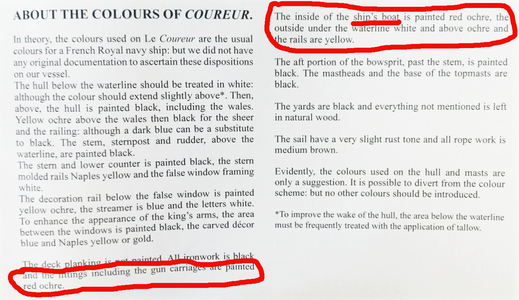This information is given by Jean Boudriot in his monograph, so if you want to paint the ship according the usual colours for the french Navy of this period ...... you should follow this information
ABOUT THE COLOURS OF COUREUR
In theory, the colours used on Le Coureur are the usual colours for a French Royal navy ship: but we did not have any original documentation to ascertain these dispositions on our vessel.
The hull below the waterline should be treated in white: although the colour should extend slightly above*. Then, above, the hull is painted black, including the wales. Yellow ochre above the wales then black for the sheer and the railing: although a dark blue can be a substitute to black. The stem, stempost and rudder, above the waterline, are painted black.
The stem and lower counter is painted black, the stem molded rails Naples yellow and the false window framing white.
The decoration rail below the false window is painted yellow ochre, the streamer is blue and the letters white. To enhance the appearance of the king's arms, the area between the windows is painted black, the carved decor blue and Naples yellow or gold.
The deck planking is not painted. All ironwork is black and the fittings including the gun carriages are painted red ochre.
The inside of the ship's boat is painted red ochre, the outside under the waterline white and above ochre and the rails are yellow.
The aft portion of the bowsprit, past the stem, is painted black. The mastheads and the base of the topmasts are black.
The yards are black and everything not mentioned is left in natural wood.
The sail have a very slight rust tone and all rope work is medium brown.
Evidently, the colours used on the hull and masts are only a suggestion. It is possible to divert from the colour scheme: but no other colours should be introduced.
*To improve the wake of the hull, the area below the waterline must be frequently treated with the application of tallow

To get an impression of the different colours, usually in the older monographs from ancre one sheet with colour samples were included (due to photographing this printed sheet the shown colours can be slghtly different to the shown)

Many Thanks to @ot1138 who mentioned this definition given by Jean Boudriot in his building l og
ABOUT THE COLOURS OF COUREUR
In theory, the colours used on Le Coureur are the usual colours for a French Royal navy ship: but we did not have any original documentation to ascertain these dispositions on our vessel.
The hull below the waterline should be treated in white: although the colour should extend slightly above*. Then, above, the hull is painted black, including the wales. Yellow ochre above the wales then black for the sheer and the railing: although a dark blue can be a substitute to black. The stem, stempost and rudder, above the waterline, are painted black.
The stem and lower counter is painted black, the stem molded rails Naples yellow and the false window framing white.
The decoration rail below the false window is painted yellow ochre, the streamer is blue and the letters white. To enhance the appearance of the king's arms, the area between the windows is painted black, the carved decor blue and Naples yellow or gold.
The deck planking is not painted. All ironwork is black and the fittings including the gun carriages are painted red ochre.
The inside of the ship's boat is painted red ochre, the outside under the waterline white and above ochre and the rails are yellow.
The aft portion of the bowsprit, past the stem, is painted black. The mastheads and the base of the topmasts are black.
The yards are black and everything not mentioned is left in natural wood.
The sail have a very slight rust tone and all rope work is medium brown.
Evidently, the colours used on the hull and masts are only a suggestion. It is possible to divert from the colour scheme: but no other colours should be introduced.
*To improve the wake of the hull, the area below the waterline must be frequently treated with the application of tallow

To get an impression of the different colours, usually in the older monographs from ancre one sheet with colour samples were included (due to photographing this printed sheet the shown colours can be slghtly different to the shown)

Many Thanks to @ot1138 who mentioned this definition given by Jean Boudriot in his building l og
Le Coureur 1776 CAF Model by OT1138
Hi everyone, I received my CAF model recently and like others, was missing E1/E2. Seeing as I had to wait for these to arrive as well as the Ancre monograph, I thought I would start with the smaller boat, some barrels and creates from the associated kits. At the very least, I hoped to get a...
shipsofscale.com








